Water Service Line Inventory
If you are aware of the material comprising your water service line,
click here to proceed directly to the Water Service Line Inventory survey.
To view the GIS map depicting the current results of the Water Service Line Inventory, please click here.
Welcome
Thank you for visiting our Water Service Line Inventory page. Below is a brief three-step process to help you gather information on your water service line. Please take time to read through each step. The service line is the water line that runs from the meter into your home or business or from the property line to your home or business. The images below demonstrate where MUB’s responsibility ends and the home/business owner’s begins for interior and exterior meters. Clicking on either image will direct you to a page where the drawings are enlarged. 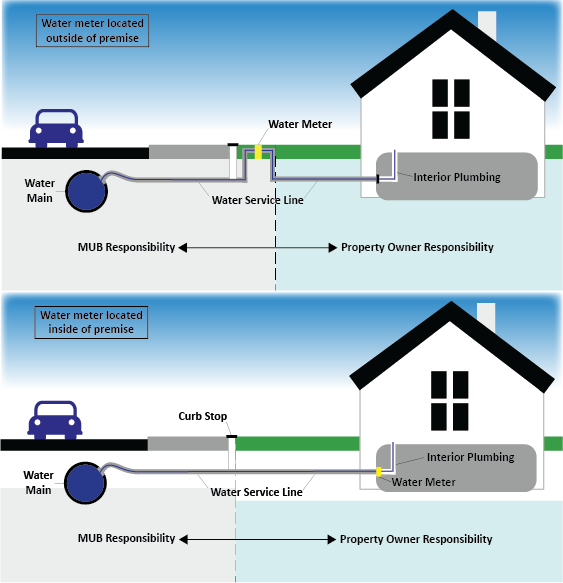
This inventory is being conducted in response to Environmental Protection Agency (EPA) rules. These rules require that water utilities identify the material of water service lines in local homes, businesses and schools. Prior to this rule, MUB only maintained records to the property line and/or meter, given that the owner of the property is responsible for the water service lines on their property.
The primary purpose of the EPA’s ruling is to identify homes that have lead water service lines. These were commonly installed in homes constructed prior to 1986. If you are not the owner of the residence or business, you may complete this process or notify the owner and request that they complete the inventory.
To date, MUB has mitigated water service line lead exposure by replacing lead service lines as identified. This program has been in existence for decades. It’s similarly important to note that we use an anti-corrosion chemical that prevents lead and other metals in the pipes from leaching into the water. This corrosion inhibitor coats the inside of lead pipes and fixtures with a thin, protective layer that reduces leaching and flaking. This is part of the reason why we have not identified lead in drinking water when random samples are tested as required.
If you have questions, please contact us at (304) 292-8443 or via email at serviceline@mub.org.
Here is a simple three-step process for completing the inventory. A printable booklet containing the below step is available via Dropbox here.
1. Getting started - locating your service line
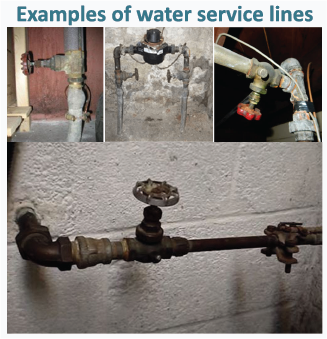 Let's begin with a question: Do you know where your water service line enters your home/business? If yes, move to Step 2.
Let's begin with a question: Do you know where your water service line enters your home/business? If yes, move to Step 2.
If not, begin by locating your water meter. Most water meters are located close to the street near the curb or sidewalk. Look for a metal or concrete lid with “Water Meter” or “Water” written on the top. Your main water service line will run underground from this meter in a straight line to the closes wall of your house. Because we live in an area prone to freezing, this line will emerge in a basement or first floor if the home does not have a basement. A valve will be attached to the line as it enters the house so a good idea is to look for it. Keep in mind that this valve could be near the floor or a above your head in floor joists. If your basement is finished it is possible that the valve has been covered. Look for access panels in ceilings, on walls or even in closets. If you are unable to locate your water service line, it may be beneficial to contact a plumber. They can both locate your line and help determine the material of the line.
2. Identifying water service line material
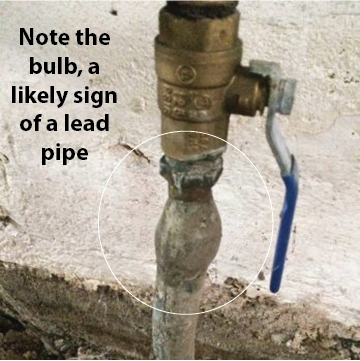 Now that the service line has been located, it’s time to determine its type. Water service lines can be plastic (PVC), copper, galvanized steel, or lead. A good place to start is a simple visual inspection.
Now that the service line has been located, it’s time to determine its type. Water service lines can be plastic (PVC), copper, galvanized steel, or lead. A good place to start is a simple visual inspection.
- Plastic is a smooth pipe of various colors (e.g., white, blue, black, and green).
- Copper is the color of a penny.
- Galvanized is a dull, silver-gray color that is difficult to scratch.
- Lead is a soft metal that is a dull, silver-gray color. It is easily scratched with a coin or key, and the scratched areas will appear shiny. Lead pipe is commonly attached to other types of pipe with a “wiped” joint. This is a rounded ball of lead that connects the pipe to other materials.
If the pipe is metal, here are some steps that may be helpful in identifying the material of the pipe.
Magnet Test
Magnets will stick only to galvanized lines, not lead or copper pipes.
Scratch Test
Use the flat edge of a screwdriver to scratch through any corrosion buildup on the outside of the pipe. Do not use a knife or other sharp instrument to prevent puncturing the pipe. Each service line type will produce a different type of scratch. When scratched:
- A galvanized line will remain a dull gray color,
- A copper line will shine and be the color of a penny,
- If the area is shiny and silver, the line is likely lead.
Tap Test:
Tap the line with a penny…
- Tapping a galvanized pipe will produce a metallic ringing,
- Tapping a copper pipe will produce a metallic ringing,
- Tapping a lead pipe will produce a dull noise.
Guide for identifying water service lines
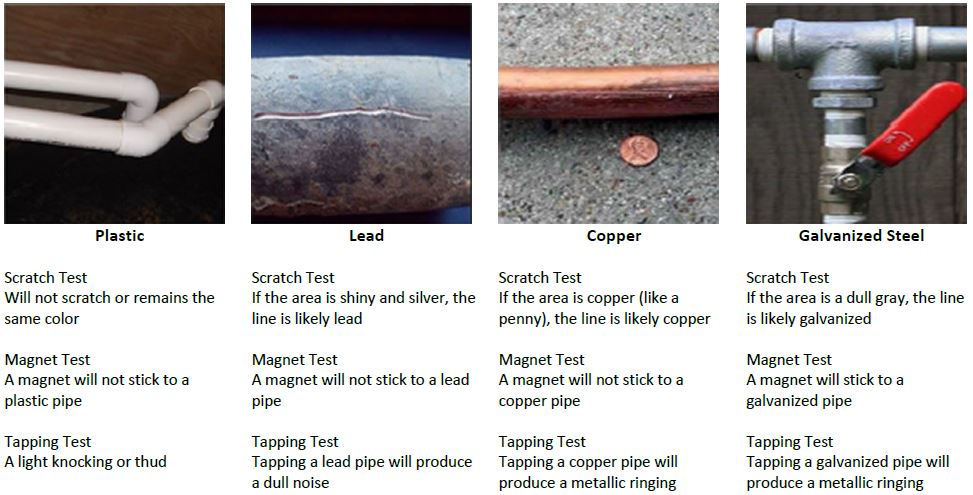
3. Reporting Results
Completing the inventory
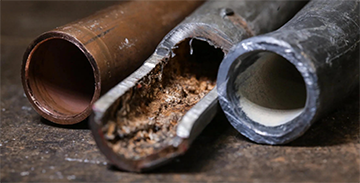 When the material has been identified, the next step is to complete the survey located here. Simply follow the link and complete the information as described. Information from the survey will be added to the record for your home.
When the material has been identified, the next step is to complete the survey located here. Simply follow the link and complete the information as described. Information from the survey will be added to the record for your home.
If you would like a paper survey, please call a MUB customer service representative at (304) 292-8443 or email mubmail@mub.org and we will be happy to send you a paper copy.
What if I believe my pipe is lead?
If you believe that you have identified a lead water service line, MUB will contact you upon completing the survey. We will discuss with you options available for moving forward.
It's important to know that having a lead pipe in your home does not necessarily equate to lead exposure. As mentioned earlier, we use an anti-corrosion chemical that prevents lead and other metals in the pipes from leaching into the water. What this corrosion inhibitor does is coat the inside of lead pipes and fixtures with a thin, protective layer that reduces leaching and flaking.
However, action is needed because elevated levels of lead can be hazardous, especially for pregnant women and young children. Here are some immediate recommendations…
- When your water has been sitting for several hours, you can minimize the potential for lead exposure by flushing your tap from 30 seconds to two minutes before using water for drinking or cooking.
- You may also wish to purchase a water filter. NSF International is the certifying body for water filtration systems. You can search for NSF certified drinking water treatment units/water filters here.
Please note that boiling water does NOT remove lead or other metals. In fact, boiling the water can increase the concentration of metals in the water due to evaporation.
The BEST solution is to remove the lead service line. Currently, the cost of doing so rests with the property owner. We will continue working closely with federal and state officials to identify funding that may become available for the replacement of lead water service lines.
Information on lead in drinking water, testing methods, and steps you can take to minimize exposure is available from the Safe Drinking Water Hotline at (800) 426-4791 or at www.epa.gov/safewater/lead.
The Water Service Line Inventory is another way that MUB works every moment of every day to meet our mission of protecting public health.
4. Use of Water Service Line Information
Information gleaned from the Water Service Line Inventory will be shared with the West Virginia Department of Health and the Environmental Protection Agency. The information will also be placed on a publicly accessible GIS map located here. Questions and answers on the Water Service Line Inventory are available on the FAQ page by clicking here.
5. Additional Links
- Environmental Protection Agency: Protect Your Tap: A Quick Check for Lead
- Centers for Disease Control and Prevention: Blood Lead Testing
- Environmental Protection Agency: Consumer Tool for Identifying Point-of-Use and Pitcher Filters Certified to Reduce Lead in Drinking Water
- Environmental Protection Agency: Learn About Lead